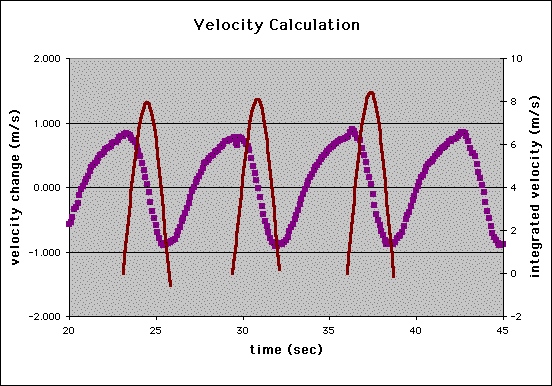
| Midway Physics Day Ride Analyses |
| Drop of Fear |
| Himalaya |
| Enterprise |
| Ferris Wheel |
| Rainbow |
| Starship 2000 |
| Swing Chairs |
| Wild Cat Roller Coaster |
| Home |

The Rainbow ride, also known as "Ala Kazam" or the "Magic Carpet" is a rotating horizonal platform. The riders sit on the platform as it rotates. As the data below indicate, your ride experience can depend of the version of the ride.
Below is data take by students from
CA Johnson High School in Columbia, SC. Plotted is the measured vertical
acceleration as a function of time.
The acceleration due to gravity is seen at the beginning of the graph as approximately
9.8 m/s^2. When the ride starts to spin in the vertical plane, the acceleration
measured is greater at the bottom of the loop and less at the top of the loop. As the
ride gains speed, the oscillation increases.

The vertical acceleration of the ride was measured with an accelerometer. This data is shown as blue diamonds in the figure below. The scale is the left y-axis. One should note that the initial value of the vertical component of the acceleration is -9.8 m/s/s. (How is this explained?) Do the riders ever feel completely weightless?
The right axis shows the net acceleration or the (acceleration - gravity). The net acceleration is used to compute the velocity. (Why?)
The radius of rotation is approximately 30 feet and the speed of rotation is 9-9.5 revolutions per minute.

By integrating the acceleration vs time curve, the change in velocity can be computed and is shown as blue squares in the Figure below. In order to get the
true velocity, the velocity is assumed to be zero at the top of the motion and the velocity curve is integrated over one-half a cycle. The result is shown as the red line in the figure with the scale on the right-hand y axis.

The Rainbow goes around in a circle and the motion should be close to that of the simple harmonic oscillator. The relation for the acceleration in simple harmonic motion is a=w^2*R*cos(w*t), where w=2*pi/T, T=period. The period is measured as the time for one complete cycle of motion. (Can you determine this number from the figure of acceleration vs time?) The Figure below shows the acceleration data (green squares) compared to the calculation of the simple harmonic oscillator. The curve fits very well except near the top of the motion as the Rainbow rises. Extra force is needed to push the ride to the top which creates a change in the acceleration.

| Midway Physics Home Page | D.J. Tedeschi Home Page | USC Home Page | USC Physics Dept. Home Page |
This page updated 24 Aug. 2001 by David J. Tedeschi
and copyright © 2001, the Board of Trustees of the University of South Carolina.